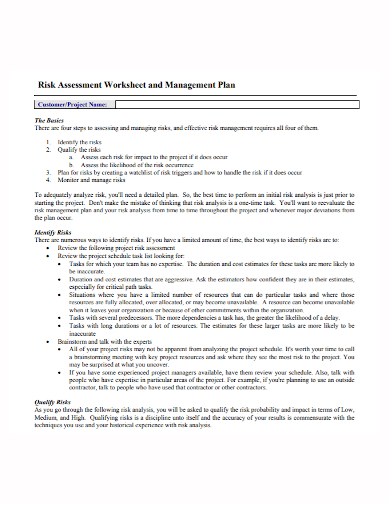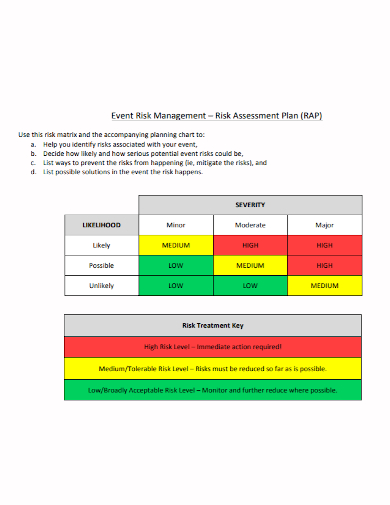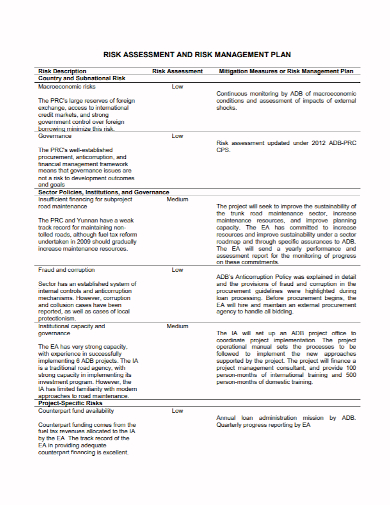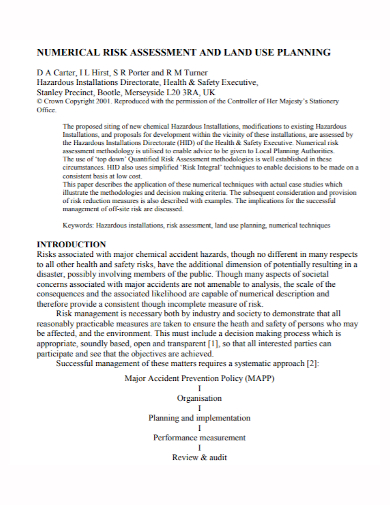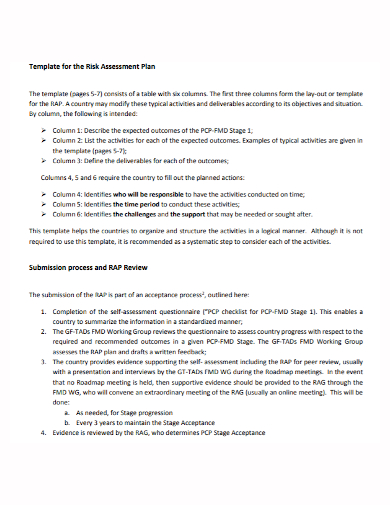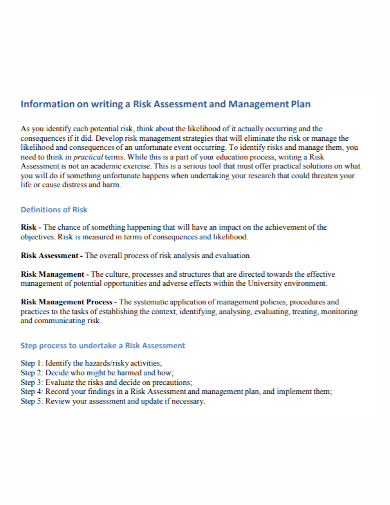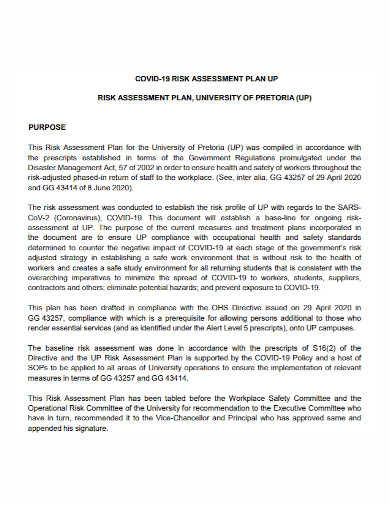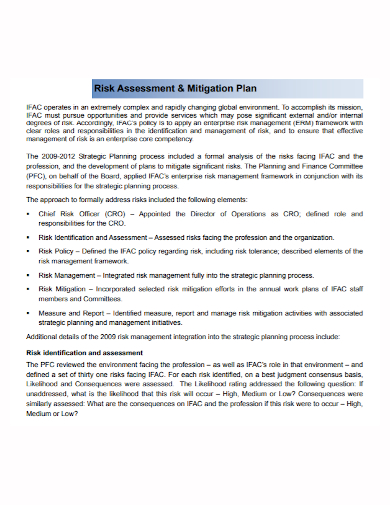In any company, risk is the primary source of uncertainty. The capacity to manage risk will enable businesses to make more confident business decisions in the future. Their understanding of the dangers they face will provide them with a variety of alternatives for dealing with future issues. This can be done through a risk assessment. Risk assessments are at the foundation of all effective health and safety regulations. Risk evaluations, on the other hand, can significantly minimize the incidence of work-related injuries and illnesses. As always, you need to have a plan to establish a solid plan. Look no further! In this article, we provide you with free and ready-to-use samples of Risk Assessment Plans in PDF and DOC formats that you could use for your convenience. Keep on reading to find out more!
10+ Risk Assessment Plan Samples
1. Risk Assessment Plan Template
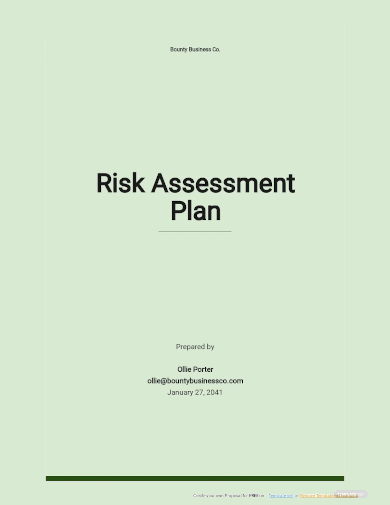
2. Risk Assessment Management Plan
3. Risk Assessment Worksheet Plan
4. Hazards Identification Risk Assessment Plan
5. Event Management Risk Assessment Plan
6. Sample Risk Assessment Plan
7. Numerical Risk Assessment Plan
8. Risk Assessment Review Plan
9. Standard Risk Assessment Plan
10. Covid-19 Risk Assessment Plan
11. Risk Assessment Mitigation Plan
What Is a Risk Assessment Plan?
A risk assessment is a method of identifying prospective dangers and determining what could happen if they materialize. Your risk assessment must show that all sections of the firm where an individual’s health might be jeopardized have been thoroughly inspected for dangers. Any dangers that pose a health risk must be recognized and necessary measures and actions taken to minimize or decrease the risk to an acceptable level.
The risk assessment plan demonstrates how possible risks are reviewed and handled to minimize any negative impact on the business. Risk identification, management, and monitoring were all developed as part of the interconnected risk assessment strategy. A risk assessment plan is a written document that outlines the risk management process for a business. This process begins with the formation of a team of stakeholders from throughout the company to assess the organization’s possible hazards.
How to Make a Risk Assessment Plan
Your risk assessment must show that all sections of the firm where an individual’s health might be jeopardized have been thoroughly inspected for dangers. A Risk Assessment Plan Template can help provide you with the format to ensure that you have a well-written and well-structured plan in hand. To do so, choose one of our excellent templates listed above so that you don’t have to draft one from scratch. If you want to write it yourself, follow these steps below to guide you:
1. Prioritize your goals
To begin, the members of the team must analyze business objectives such as product development and third-party business alliances. The risk management approach connects to present and future goals by starting with corporate objectives.
2. Determine the risks.
Reviewing digital assets such as systems, networks, software, devices, vendors, and data is the second phase in building a risk management plan. The team members can then identify threats to the assets by cataloging them. A risk, often known as an unpredictable occurrence, is a positive or negative circumstance with financial, operational, or reputational consequences.
3. Calculate the risk’s impact.
For each risk identified and analyzed, the team must consider the possibility of the event occurring, as well as the business effect if it does. The effect of a risk may be determined by multiplying the likelihood by the expected impact. A low-probability danger has a catastrophic financial consequence. Meanwhile, a high-probability danger may have little effect. The risk assessment matrix is created as part of the quantitative or qualitative investigation.
4. Reduce the hazards.
The team must develop a set of risk mitigation methods for acknowledged hazards. Every risk that a company takes or transmits must be accompanied with answers to potential concerns. In the context of information security, this entails putting in place safeguards to protect data from cybercriminals. As a result, risk mitigation techniques serve as a contingency plan in the event that the event occurs, assisting in limiting the stated impact.
FAQs
In a company plan, how crucial is risk assessment?
To begin with, it aids in the identification, management, and reduction of various hazards in your company. It also aids in the protection of employees’ well-being. Prior to the invention of software, companies had to rely on a time-consuming paper-based risk assessment approach.
What is the purpose of risk analysis?
Risk analysis is important in a variety of scenarios, such as project planning, to help you foresee and eliminate potential difficulties. When determining whether or not to pursue a project further. When it comes to increasing workplace safety and minimizing possible hazards.
Why is it vital to take good risks?
It entails minimizing hazards in order to increase people’s freedom of choice and control over their life. Good risk taking recognizes that, despite its potentially bad aspects, risk taking may provide individuals with positive rewards, allowing them to achieve things that other people take for granted.
A solid risk management strategy will assist a firm in establishing processes to avoid possible dangers, reduce their effect if they do materialize, and deal with the consequences. Organizations can be more confident in their business decisions if they can recognize and handle risk. To help you get started, downloaded our easily customizable and comprehensive samples of Risk Assessment Plans today!
Related Posts
FREE 12+ Sample Security Risk Assessment
FREE 10+ Fire Risk Assessment Samples
FREE 10+ HR Assessment Checklist Samples
FREE 10+ Sample Health Risk Assessments
FREE 10+ Sample Risk Management Plan
FREE 8+ Sample Project Risk Management
FREE 7+ Sample Risk Assessment Report
FREE 6+ Inventory Risk Management Samples
FREE 6+ Security Assessment Templates
FREE 11+ Sample IT Risk Assessment
FREE 10+ Child Care Risk Management Plan Samples
FREE 10+ Liability Risk Assessment Samples
FREE 10+ Investment Risk Management Samples
FREE 10+ Vulnerability Assessment Samples
FREE 8+ Currency Risk Management Samples


